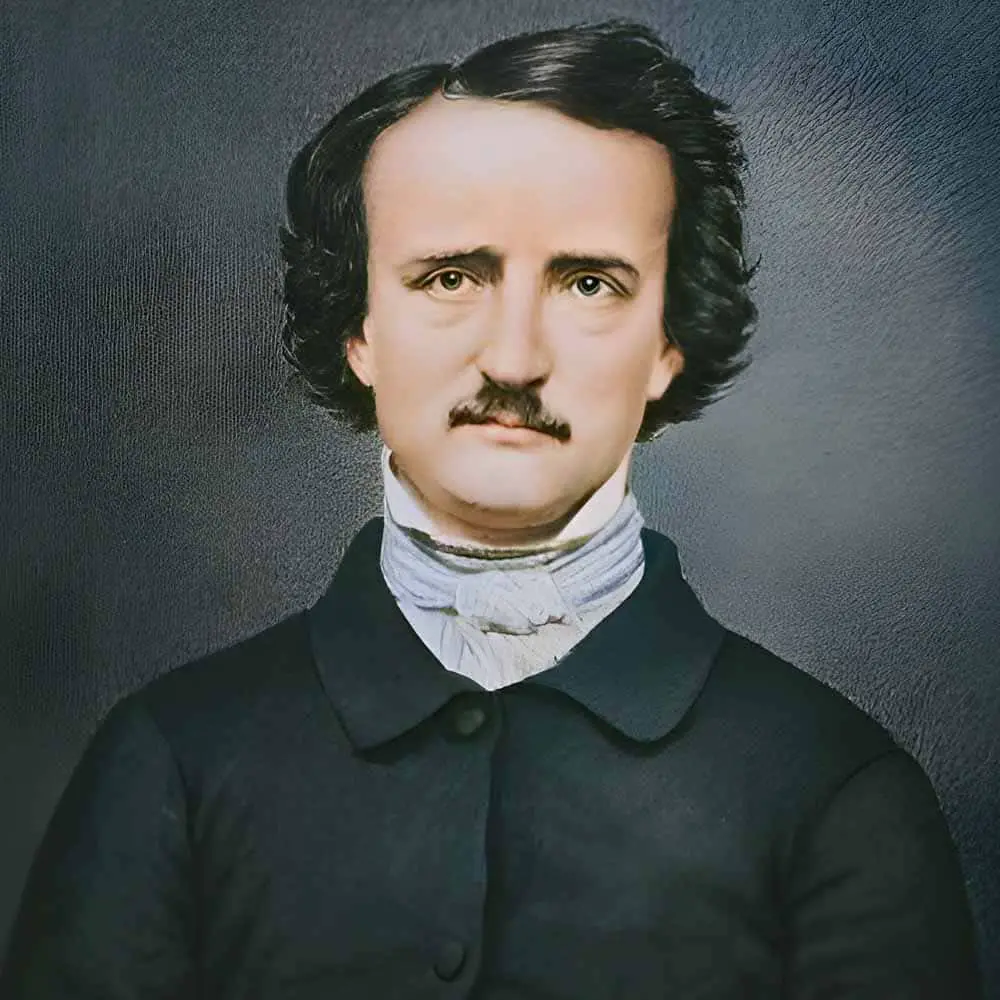
Edgar Allan Poe: Unveiling the Master of Macabre’s Legacy
Born: 19 January 1809
Died: 7 October 1849
Country: United States of America
Notable Works: “The Tell-Tale Heart,” “The Fall of the House of Usher,” “The Murders in the Rue Morgue,” “The Raven,” “Eureka”
Edgar Allan Poe remains one of the most significant and influential American writers of the 19th century. Born on January 19, 1809, in Boston, Poe crafted a legacy rooted in the macabre and the mysterious, often credited with pioneering the horror genre and refining the detective fiction format. His turbulent life, marred by personal tragedies and financial difficulties, often mirrored the dark, emotional undertones that characterize his literary work.
His contributions to the world of literature include a collection of poems, short stories, and essays that explore themes of death, reanimation, and psychological horror. Poe’s poem “The Raven,” with its haunting refrain of ‘Nevermore,’ stands as a hallmark of his poetic prowess and command of language, while stories like “The Tell-Tale Heart” and “The Fall of the House of Usher” exemplify his talent for crafting suspenseful, atmospheric narratives.
Moreover, Poe’s character C. Auguste Dupin, introduced in the story “The Murders in the Rue Morgue,” is often regarded as the prototype for future fictional detectives, influencing characters in later works by writers such as Sir Arthur Conan Doyle and Agatha Christie. The complexity of Poe’s characters and the depth of his vision cemented his position not just in American literature, but in the broader context of literary history world over. His impact on genres like science fiction and gothic fiction underscores the breadth of his creativity and the enduring appeal of his works.
1. Early Life and Education
Edgar Allan Poe’s formative years were marked by poignant events, including his adoption and ensuing education that laid the groundwork for his literary prowess.
1.1. Parentage and Adoption
Edgar Allan Poe was born on January 19, 1809, in Boston. His parents, Elizabeth Arnold Hopkins Poe and David Poe Jr., were both actors by profession. Poe’s early life was upended after his father abandoned the family in 1810, and his mother passed away a year later from tuberculosis. Subsequently, Edgar was taken in by John and Frances Allan of Richmond, Virginia. Though they never formally adopted him, Poe was raised in their home, and he adopted the Allan name as part of his own, reflecting his complex relationship with his foster family.
1.2. Childhood in Richmond
Poe’s childhood in Richmond provided cultural enrichment but was marked by fluctuating fortunes due to John Allan’s erratic business success. The Allans supported Poe’s education, enrolling him in private schooling where he laid the foundation for his understanding of classics and language.
1.3. University of Virginia
In 1826, Poe attended the University of Virginia, excelling in languages. His tenure was brief, however, due to financial struggles stemming from John Allan’s limited support and Poe’s own gambling debts. The severity of these debts and their role in Poe’s departure from the university has been a subject of historical debate, with some suggesting that Allan’s lack of financial support was a significant factor.
2. Literary Beginnings
Edgar Allan Poe’s literary career began with his early poetic works, followed by his critical role as a writer and editor for the ‘Southern Literary Messenger’ in Richmond.
2.1. Early Works
Poe’s literary foray began with his poetry, displaying his budding talent. In 1827, he published “Tamerlane and Other Poems” anonymously, showcasing his developing style. This collection, attributed to “a Bostonian,” hinted at Poe’s early persona as a writer.
2.2. First Publications
The initial reception of “Tamerlane and Other Poems” was muted, largely due to its anonymous publication and limited distribution. However, the work signaled Poe’s emerging potential. By 1829, Poe released “Poems,” featuring pieces like “Al Aaraaf” and “To Helen,” and began establishing his literary presence.
2.3. Southern Literary Messenger Editorship
Poe’s tenure at the Southern Literary Messenger in 1835 marked a pivotal period in his career, showcasing his talents as a writer and critic. His work contributed significantly to the magazine’s success and played a crucial role in shaping the American literary landscape.
3. Major Works and Contributions
Edgar Allan Poe’s literary achievements encompass a broad spectrum of poetry and prose, marked by his influential role in developing the genres of detective fiction and the macabre. His writings remain a cornerstone in American literature.
3.1. Prolific Period in Philadelphia
During his prolific period in Philadelphia, Poe penned some of his most significant works, contributing greatly to the genres of horror and mystery with short stories that showcased his unique style. While residing in Philadelphia from 1838 to 1844, he produced such notable tales as “The Fall of the House of Usher,” which epitomized his flair for weaving elements of terror and beauty into a cohesive narrative.
3.2. The Raven
“The Raven,” published in 1845, stands out as Poe’s most famous poem and is widely recognized for its stylized language, musical rhythm, and supernatural atmosphere. The poem’s central theme of inconsolable grief, expressed through the haunting refrain “Nevermore,” has had a persistent impact on American culture and literature.
3.3. Detective Fiction Pioneering
Poe’s work “The Murders in the Rue Morgue” (1841) introduced the world to detective fiction, a genre that he was instrumental in creating. This short story featured the analytical sleuth C. Auguste Dupin, who utilized deduction to solve a seemingly inexplicable crime, thus establishing the template for future fictional detectives.
3.4. Literary Style and Themes
Poe’s literary style is distinctly characterized by a focus on the macabre and the inclusion of gothic elements that stimulate feelings of horror among readers. His narratives often delve into themes of death, decay, and the human psyche, blending with a tonality that is elaborate yet clear. His influence on the horror genre is pervasive, with his explorations of the dark sides of human experience resonating through time.
4. Edgar Allan Poe Personal Life and Struggles
Edgar Allan Poe’s personal life was marked by a series of hardships, including a tumultuous marriage, pervasive financial difficulties, and persistent health issues that plagued him until his death.
4.1. Marriage and Family
Edgar Allan Poe married his cousin, Virginia Clemm, in 1836 when she was just 13 years old, and he was 27. Interpretations of their relationship vary, with some sources suggesting a close and affectionate bond. Their household, including Maria Clemm, Virginia’s mother, often faced financial precarity. Virginia’s struggle with tuberculosis profoundly affected Poe, and her death in 1847 deeply influenced his subsequent works.
4.2. Financial Difficulties
Poe’s life was a constant battle with financial instability. Despite his recognition as a talented writer and editor, his earnings were insufficient for a comfortable living. His early gambling contributed to his financial woes, but the primary factors were the low compensation for literary works and the lack of copyright protection for his writings.
4.3. Health Issues
Poe’s health and his alleged alcoholism are subjects of scholarly debate. While Poe did seek help for alcohol use and experienced several illnesses, the extent to which alcoholism impacted his life and work is contested. His wife Virginia’s battle with tuberculosis added to his emotional and financial burdens.
Poe died under mysterious circumstances in Baltimore in 1849. The exact cause of his condition at the time of his death remains one of the many enigmas surrounding his life.
5. Legacy and Influence
Edgar Allan Poe’s passing led to a profound expansion of his fame, influencing literature and popular culture while maintaining relevance for readers and writers alike.
5.1. Death and Posthumous Fame
The death of Edgar Allan Poe on October 7, 1849, marked a transformation in his recognition. Posthumously, Poe’s work received heightened attention and critique, elevating his status within American literature. Despite the mysterious circumstances surrounding his death, with theories ranging from alcoholism to rabies, Poe’s reputation as a central figure in the gothic genre has only grown.
5.2. Impact on Literature and Popular Culture
Poe’s influence extends significantly within American literature and beyond, affecting various genres and readers worldwide. His literary techniques and themes have been studied extensively in education systems, with books such as The Raven and The Tell-Tale Heart becoming staples in the curriculum.
- Impact on Authors: Poe’s methods have inspired a myriad of writers, including Charles Baudelaire, who translated his works into French, praising Poe’s genius.
- Popular Culture: Poe’s stories and poems have been adapted into numerous films, shows, and other media, perpetuating his themes and aesthetics in the wider cultural milieu.
5.3. Continued Relevance
Poe’s biography, infused with tragedy and enigma, has continued to fascinate the public and scholars, enriching the exploration of his literary contributions. Notably, his essay “Eureka” ventured into cosmology, presenting a universe of infinite expansion that some claim anticipated aspects of later scientific theories. Poe’s work remains an integral part of education, with readers appreciating his storytelling mastery and emotional depth. As a result, his legacy endures, making him a timeless fixture in both American literature and a broader international context. His craft stimulates ongoing scholarly discussions and continues to resonate with contemporary audiences.
6. Chronology and Critical Analysis
Edgar Allan Poe was an eminent American writer known for his macabre and gothic tales. His work as a literary critic and author left an indelible mark on the literary landscape of the 19th century. The following subsections will detail the timeline of significant events in Poe’s life and assess his contributions to literature.
6.1. Timeline of Significant Events
1809: Born in Boston, Poe was the second of three children. His early years were marked by the death of his parents, after which he was taken in by the Allan family of Richmond, Virginia.
1826-1830: Poe attended the University of Virginia and later enlisted in the United States Army. He also secured a nomination to the United States Military Academy at West Point but was eventually dismissed.
1831-1835: After leaving West Point, Poe moved to New York and then to Baltimore, where he concentrated on his career as a poet and author. “The Gold Bug,” one of his notable works, was published during this period.
1836-1849: Poe married his 13-year-old cousin Virginia Clemm and shifted between Richmond, Philadelphia, and New York, engaging in various editorial and literary positions. In 1845, he published “The Raven,” which brought him national fame.
1849: Poe passed away under mysterious circumstances in Baltimore.
6.2. Assessment of Poe’s Contributions
Edgar Allan Poe is celebrated for pioneering the American short story genre and is often hailed as the architect of modern detective stories. His use of psychological depth in gothic horror, as seen in The Tell-Tale Heart, changed the landscape of horror fiction.
His criticism work was equally profound, as it laid foundations for both contemporary and modern literary theory. With “Eureka,” he made a foray into cosmology that some claim anticipated later scientific theories.
In summary, Poe’s legacy as a poet, author, and critic had a profound influence on American and international literature, offering innovations in style, storytelling, and literary criticism that resonate to this day.




